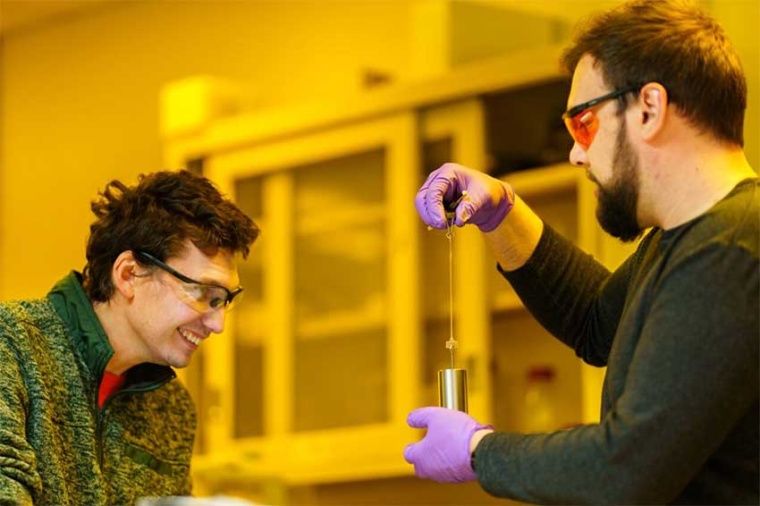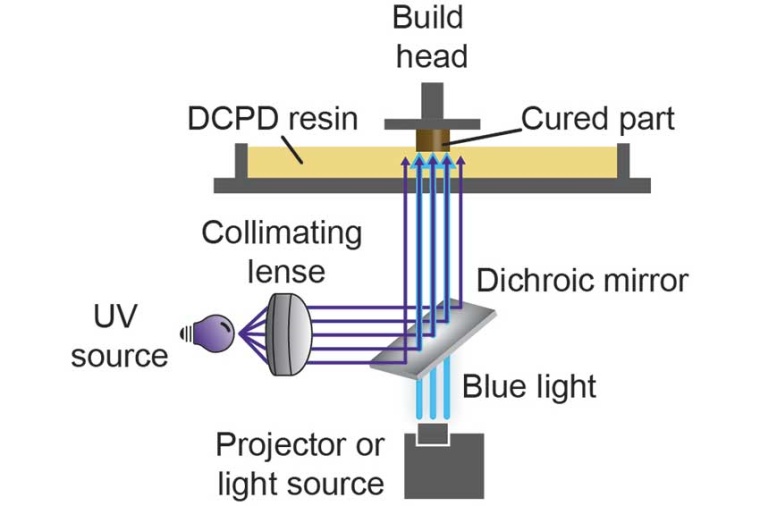Printing stronger materials five times faster
A new process using light at two wavelengths creates stronger nonmetallic materials five times faster than traditional additive manufacturing.
A team of chemists and materials scientists at Sandia National Laboratories took inspiration from a technique known as continuous liquid interface printing along with a printing approach using dual-wavelength light for acrylic-based polymerizations. With it, they created SWOMP, selective dual-wavelength olefin metathesis 3D printing. As indicated by its name, it uses two different wavelengths, unlike the traditional printing process. In this case, ultraviolet and blue.


Traditionally, vat 3D printing is accomplished by irradiating a vat of photosensitive liquid resin in a desired pattern. As the resin is exposed to light from beneath the vat, the resin cures and hardens into a polymer layer. The cured polymer is then lifted, and a new pattern is projected beneath to cure subsequent layers. As the polymer cures, it adheres to the previous layer and to the bottom of the vat. After each layer, the cured polymer must be slowly peeled from the vat to prevent damage, significantly slowing down the 3D printing process.
Material sientists Samuel Leguizamon, Leah Appelhans, former Sandia employee Jeff Foster, and polymer scientist Alex Commisso came up with a way to cool the polymer quicker.The key is combining two beams of different colors.
“You are still printing layer by layer, but you are using a second wavelength of light to prevent polymerization at the bottom of the vat. So it doesn’t adhere to the bottom,” Leguizamon said. “That means you can lift the cured polymer part more quickly and speed up the printing process significantly.”
But this new process is not just about efficiency. It’s about making 3D-printed materials stronger and more versatile. The team turned to the material dicyclopentadiene, which is commonly used in the production of paints, varnishes and flame retardants for plastics. They were able to develop a way to polymerize it more rapidly with light so that it can be used more efficiently in 3D printing.
One day, they hope to see these 3D-printed parts in rockets, engines, batteries and maybe even in fusion applications. Leguizamon said they are already talking with researchers at Lawrence Livermore National Laboratory to explore applications.
Company
Sandia National Laboratories1515 Eubank SE
Albuquerque, NM 87123
US
most read

Softbank acquires ABB's robotics business
The Softbank Group has reached a definitive agreement to acquire ABB's robotics business.

HMS Networks takes over Industrial Communications division from Molex
This strategic acquisition includes intellectual property in hardware and software, a product portfolio with network cards and software stacks, as well as customer relationships in the USA and Japan.

Microvista expands management team with new dual leadership
Dr. Robin Höhne joins company founder Prof. Dr. Lutz Hagner as Chief Executive Officer.

Change in management at Stemmer Imaging: Arne Dehn steps down
New interim CEO Paul Scholten takes over management

New member of the board of VDMA Robotics + Automation
Dr. Michael Jürgens, CEO of Kuka Robotics, has been appointed to the board of the VDMA trade association.






